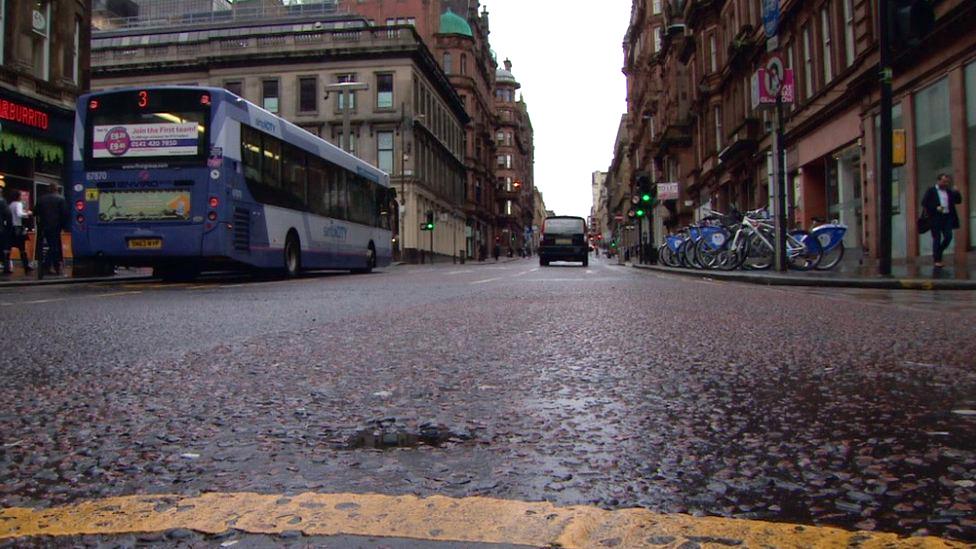Most-polluted street breaches air quality limit
- Published

Hope Street in Glasgow is the most polluted street in Scotland
Air quality on Scotland's most polluted street breached legal limits last year despite the continued reduction in traffic due to Covid restrictions, environmental campaigners have said.
Hope Street in Glasgow recorded an annual average above the legal limit for vehicle fuel pollution, according to Friends of the Earth Scotland.
Other streets across Scotland also saw a rise in air pollution last year.
The previous year saw pollution remain within legal limits for the first time.
The sudden fall in 2020 came when the first Covid lockdown removed most vehicles from city centres, where most air quality monitors are situated.
The campaign group analysed official air pollution data for 2021 from these monitors, looking at two pollutants which are primarily produced by transport - nitrogen dioxide (NO2) and particulate pollution (PM10).
The legal limit for NO2, set by the European Ambient Air Quality Directive, is 40 mcg/m3.
Hope Street in Glasgow had an annual average of 45.411 last year, up from 35.87 in 2020.
Salamander Street in Edinburgh is the dirtiest street for levels of particulate matter, which is another measured pollutant.
But at 15.4 mcg/m3 it is below the legal level of 18 mcg/m3.
Nitrogen dioxide pollution
Glasgow Hope Street - 45.411 (NO2 Nitrogen Dioxide Annual mean (µg/m3))
Dundee Lochee Road - 31.840
Falkirk West Bridge Street - 31.219
Perth Atholl Street - 31.077
Dundee Seagate - 30.136
Edinburgh Queensferry Road - 29.625
Fine particle (PM10) pollution
The Scottish annual statutory standard for particulate matter (PM10) is 18 micrograms per cubic metre.
Edinburgh Salamander St -15.439 (PM10 annual mean (µg/m3))
Perth Atholl Street - 14
Glasgow Kerbside (located on Hope Street) - 13.138
Fife Cupar - 12.955
Aberdeen Wellington Road - 12.314


These annual figures from Friends of the Earth Scotland highlight the link between air quality and commuting.
When we were routinely driving to work the figures were high, when we stayed at home they were low.
Now we are in that middle ground where many are still operating from their back bedroom - and the figures reflect that.
With Covid numbers dropping, some are arguing we should go back to the way we were before.
But that will inevitably mean dirtier cities and so the choice of the type of air we breathe now lies in our hands.

Friends of the Earth Scotland's transport campaigner, Gavin Thomson, said: "2020 was an outlier for obvious reasons and we witnessed unprecedented changes to all areas of public life. But for traffic emissions, it was back to business as usual in 2021.
"From the evidence we have, virtually every street in Scotland experienced higher levels of pollution in 2021 than the previous year."
Mr Thomson said air pollution from transport was responsible for thousands of premature deaths in Scotland every year, from causes such as serious heart and lung issues.
Related topics
- Published17 January 2021
